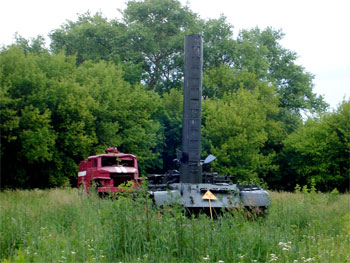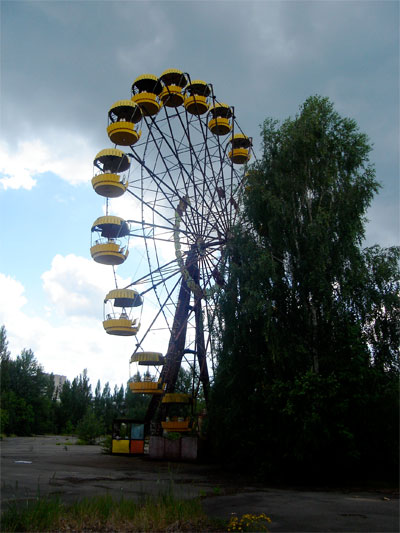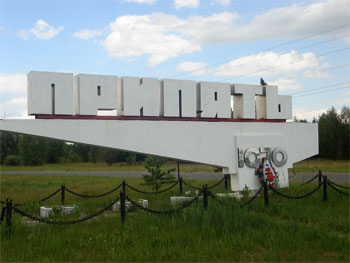
When discussing future travel plans to visit the Chernobyl oblast prior to an imminent visit to Kiev, Ukraine’s capital city, it was surprising to receive two incredibly polar responses. The first was one of little interest – Chernobyl barely registered on many people’s radars as anything but another town on a long itinerary of destinations. The second, however, was one of fear – fear that time spent at the site of the world’s greatest nuclear accident to date would mean returning glowing yellow like a character from the Simpsons. Either way, and understandably so, for the majority of tourists a visit to the site of a nuclear accident is probably of little allure. Nevertheless, if you have made it to Ukraine in the first place, chances are a trip to this ghost town would excite you too. This certainly appears to be the belief of several Ukrainians who are jumping on the current eco-tourism bandwagon and arranging regular trips for tourists to the nuclear exclusion zone.
Before arriving in Kiev it was necessary to contact one of the growing number of Ukrainian tour operators offering trips to Chernobyl such as Sergei at Solo East Travel (www.tourkiev.com). Sergei arranges trips to the exclusion zone for up to three days. The price of the daytrip starts at 3,000 Ukrainian Hvyrnia, around £300, but the greater the number of people on the tour that day, the lower the cost.

On the day of the tour Sergei arranges for his colleague, Ivan, to meet with the eco-tourists on the main square in Kiev, the site of the 2004 Ukrainian Orange Revolution. The average annual income in Ukraine is just £3,500 so to Ivan and Sergei each trip is a lucrative business transaction. On the day of my trip an 875 Hvyrnia, £88, payment per person was required, after which, having ushered the eager eco-tourists into a small white minibus for the hour-and-a-half journey to Chernobyl, Ivan disappeared, no doubt to the bank!
On arrival at the perimeter of the 30-km exclusion zone the military guards survey the necessary documentation, including passports, which are required to permit entry.It is an intimidating experience, but wholly worthwhile because only then can the expedition into the savage world of nuclear devastation proceed.The landscape is littered with small, abandoned houses, now ruins, engulfed by encroaching triffid-like vegetation, and reflecting the desolate nature of their surroundings.
Red and yellow danger signs, warning of highly contaminated buried buildings, permeate the landscape. As with many problems, ideological or physical, in the former Soviet Union, burial has proven not to be a long-term solution and this approach to the contamination has since ceased.
The tour is preceded by a brief talk by a guide about the history of Chernobyl.

During the ten days subsequent to reactor #4’s explosion on the 26th April 1986, the Ukrainian and Soviet authorities evacuated 116,000 people to other towns and cities.Despite government regulations, 2,000 of those so resettled chose to return to the 30-km exclusion zone.Now there are just 300 people living within the Chernobyl oblast, two of which live alone within the central 10-km exclusion zone.
Although the Ukrainian government forbids anyone to live within the Chernobyl oblast, the elderly who have returned are allowed to live out their dying days peacefully.
The government provides them with some medical care and transport to shops on a regular basis.In many respects those still living in the exclusion zone live as normal a life as any resident of any country village throughout the world; they are no more removed from society than many elderly people in English country villages.In fact, the Chernobyl residents probably benefit from a more frequent bus service and more frequent home visits by doctors.
These people seem content with their quiet lives and grow the majority of their own food, although doing so flouts legislation.

Following the brief introduction to Chernobyl’s history and after signing an agreement to the various rules which must be abided by during the visit, including not standing on moss because the way plants absorb radiation makes them potentially very harmful to human beings, the visitors return to the minibus for the tour to commence.
During the tour many of the sites are large and/or striking, for example, the evident inadequacy of the vehicles used in the clean-up operation, the Sovietesque memorial to the fire-fighting services, the abandoned shipping port and rusting ships, the blackened forest and even reactor #4.
However, nothing compares to the eerie ghost town of Pripyat. Once home to 49,000 people, Pripyat is an example of a perfectly preserved Soviet town but now houses just one lone elderly couple. The Soviet housing blocks, still containing their former residents’ belongings, cannot fail to make you gasp. Now decaying, the then brand new and unused football stadium and ferris-wheel, which were to be unveiled to celebrate May Day just days after #4’s explosion, are a grim reminder of what life was like in the Soviet Union, superficially appearing grand and elaborate, but, in reality, highly dangerous.
Trips to Chernobyl are rounded off with a traditional Ukrainian meal, none of the produce of which is sourced locally for fear of contamination. The women employed to cook for those working in the area present a veritable feast: a selection of cold meats, salad, bread, delicious borscht soup and a plate of grilled meat, served with small potato chips.

This is possibly the most poignant eco-tourism trip one could take. Politicians from all over the world should visit Chernobyl before they consider commencing extolling the virtues of nuclear power in an effort to justify further investment in this technology.
When leaving Chernobyl, on reaching the perimeter of the exclusion zone, visitors are required to exit the minibus in order for the guards to check personal radiation levels. Having been there for such a brief time and some 22 years after the accident, levels of personal radiation appear to be no greater than on arrival.
It is said that during a flight between the UK and the USA more radiation is absorbed into the human body than is the case when visiting Chernobyl for a short time. Of course, those living within the region in 1986 were not as fortunate, and reported cases of thyroid cancer and other health complaints are numerous, not also forgetting the deaths due to radiation sickness which occurred during and just days after the explosion.








